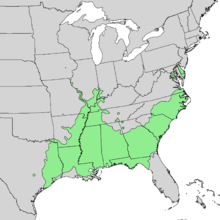Quercus lyrata
| Overcup oak | |
|---|---|
.jpg) | |
| Scientific classification | |
| Kingdom: | Plantae |
| (unranked): | Angiosperms |
| (unranked): | Eudicots |
| (unranked): | Rosids |
| Order: | Fagales |
| Family: | Fagaceae |
| Genus: | Quercus |
| Section: | Quercus |
| Species: | Q. lyrata |
| Binomial name | |
| Quercus lyrata Walter | |
 | |
Quercus lyrata (overcup oak) is an oak in the white oak group (Quercus sect. Quercus). It is native to lowland wetlands in the southeastern United States, from Delaware and southern Illinois south to northern Florida and southeast Texas.
.jpg)
It is a medium-sized deciduous tree, growing to 20 m tall, with a trunk up to 80 cm (rarely 140 cm) diameter. The leaves are 10–16 cm (rarely 20 cm) long and 5–10 cm broad, deeply lobed, often somewhat lyre-shaped (lyrate), dark green above, paler and often finely hairy beneath. The flowers are catkins, produced in the spring and maturing in about 6–7 months into acorns 2.5–5 cm long and 2–4 cm broad, largely enclosed by the cupule (acorn cup).
The common name comes from the acorns being largely enclosed in the cup; the scientific name comes from the lyrate (lyre-shaped) leaves.
The wood is valuable, similar to that of other white oaks, and used for the same purposes.